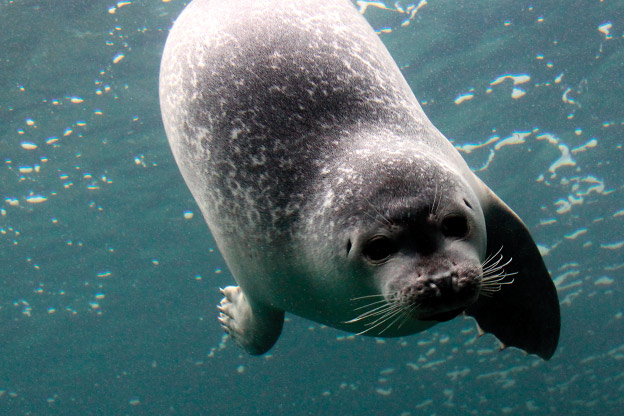Early summer means harbor seal pupping season for inland Puget Sound waters and the Pacific Northwest coast. It’s hard to imagine a more adorable creature than a harbor seal pup with its round furry body, dabbled fur, doll-eyes, and whiskered face. The pups lounge on the beaches and old floating docks like they don’t have a care in the world as mom watches over them. But the idyllic picture hides the harsh reality of seal life, according to Seal Sitters Marine Mammal Stranding Network, an all-volunteer group dedicated to the protection of marine mammals. Their jurisdiction is West Seattle, prime location for seal pup and human interactions.
 “Only 50% of harbor seals survive their first year,” says Robin Lindsay, Lead Investigator for Seal Sitters. Mother seals wean their offspring after a brief four-to-six weeks, and these “weaner” pups are left to fend for themselves. In their inexperience, exhausted pups often haul out on urban beaches where they come into contact with people and dogs.
“Only 50% of harbor seals survive their first year,” says Robin Lindsay, Lead Investigator for Seal Sitters. Mother seals wean their offspring after a brief four-to-six weeks, and these “weaner” pups are left to fend for themselves. In their inexperience, exhausted pups often haul out on urban beaches where they come into contact with people and dogs.
“The main thing is, people in any kind of vessel who approach hauled-out seals seriously jeopardize the health of resting seals,” says Lindsay. It’s important to know that when a seal is hauled-out on land, it is taking a critical rest to go back into the sea. Interrupting a seal’s rest and flushing it into the water forces it to expend precious calories needed to survive. Pups can be trampled or abandoned. Lindsay shares a story.
“One time I was out with a biologist and [we were] observing a female who was giving birth and a speedboat full of loud people flushed the mother into the sea. She left her newborn on the shore. What is scary about that scenario is that the initial bond between mother and pup is vital, who knows if she bonded properly?”
What is the best thing to do when you see a hauled-out seal pup? Leave it alone and give it at least 100 yards of space. It is perfectly normal for unweaned seal pups to be left alone on land for extended periods of time, and weaned pups who are supposed to be alone can have little outward differences in appearance to unweaned pups. The same guideline applies to seals on buoys. It’s also important to note that touching harbor seals is illegal.
“Boaters need to follow the same recommendations as people who come across them on land, so stay 100 yards away,” says Lindsay. However, if a seal pup happens to hop onto your transom or kayak, you’re in for a treat. Lindsay recommends that—provided you have the time— allow the animal to rest. “Enjoy the experience! Just make sure to not transport the pup out of the area. You do not want to separate the pup for its mother who may be swimming nearby.” If you really must go on your way, gently (and safely) ease the seal back into the water.
So when it comes to seals, stay away and don’t transport them out of the area where they were found. If you’re so inclined, check out the Seal Sitters website for more information, including volunteer opportunities to get involved (sealsitters.org). If you see a seal or other marine mammal in distress on the beaches of West Seattle, call the Seal Sitters hotline at 206-905-7325. For other beaches on the Washington and Oregon Coast, call the NOAA West Coast MMSN stranding hotline at 1-866-767-6114.